




George III acted as monarch between 1760 – 1820, and was the first Hanoverian king to speak English. During his reign British society and politics underwent vast changes that began to shape a new direction for upcoming years. Crucially, Ireland merged with the rest of Britain after the Act of Union, and we had the beginnings of the united Kingdom. Although Britain was a leading country in Europe at the time, there were disappointments and problems, such as the loss of American colonies after the American War of independence in 1775. These American colonies considered themselves a part of Europe and reproduced European homes ands style of the past. They replied on Britain for trade, but it was after the taxation of these colonies to help pay for the French and Indian wars that they declared independent. During the reign of George III there were the beginnings of the industrial Revolution, mainly the beginning of the Factory Age with the first cotton mill created in Derbyshire. Up until this moment in time, British industry had been fairly small and unsophisticated, but with continuing improvements in factory production, coal mining and transport growth this all changed. Now we had a society that was growing and developing rapidly, for example transport made huge strides with the improvements of roads, as a drive from London to Edinburgh that would have previously taken 2 weeks, now only took 2 days.
Key Events during the Neoclassical period:
• The invention of the spinning jenny by James Hargreaves 1764
• The invention of the steam engine by James Watts 1769
• Beginning of the Factory Age 1771
• The outlaw of slavery 1772
• American War of independence 1775
• The beginning of the French Revolution 1789
• Britain joins the war on France 1793
• George III
• William Benson
• John Soane
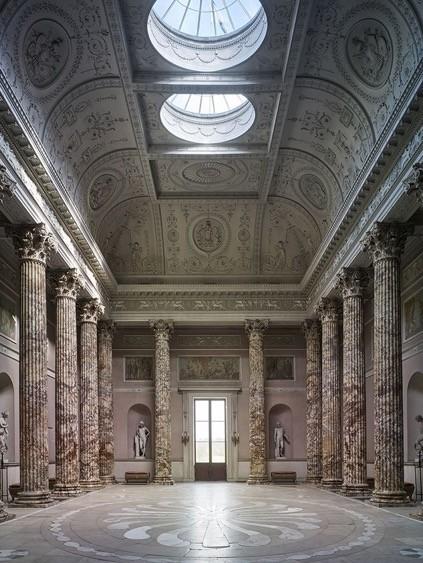
• Antoni Zucchi
• George Hepplewhite
• Thomas Chippendale
• Thomas Sheraton
• Robert Adam
• William Wilkins
• William Chambers
• John Nash
• Sir Robert Smirke
Kedleston Hall designed by dominant architect of neoclassical works, Robert Adam.Neoclassical style emerged forma reaction against the overindulgence and lavish style of Palladian and Baroque. Instead Neoclassicism referred back to classical architecture and styles, heavily influences by ancient Greece and Rome, in particular the ruins of Herculaneum and Pompeii. Many affluent members of society returned from travels across Europe and the grand tour with inspiration and appreciation of foreign cultural influences. These were newly discovered influences at the time, and in particular the roman and Greek mythologies sparked interest with British society. There was a revival or orderly, symmetrical and rationale architecture, it was embraced by many and there was a sense of balance and consistency as both grand stately homes and modest townhouses were created in this style. In politics, the conservatives were in power and they too prefer this style, a movement away form decorative and ornate neo palladium, instead there was a rational, logical and stricter sense of style that could fit with their ideals. An appreciation of neoclassic was widespread across Europe and its influences were seen in abundance through art, literature, philosophy, musical and archaeology.
The library at Kenwood House, designed by Robert Adam. Features classic columns, decorative frieze, ceiling paintings by Antoni Zucchi and use of neoclassical motifs.





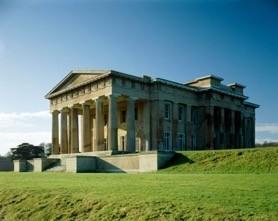 Northington Grange designed by architect William Wilkins.
Saltram House designed by Robert Adam
Plasterwork and imagery on the ceiling within Saltram House were painted by Antonio Zucchi.
Northington Grange designed by architect William Wilkins.
Saltram House designed by Robert Adam
Plasterwork and imagery on the ceiling within Saltram House were painted by Antonio Zucchi.

A significant piece of architecture and interior design within the Neoclassical design movement, this building was a creation of iconic designer Robert Adam. He rebuilt it in 1761 and redefined the style to be quintessentially neoclassical, with its columns and rigid structure on the outside, whilst inside there was a focus on oval motifs with classical themes, elaborate wall and ceiling panels and statues places within niches. Adam had a distinctive restrained style that was elegant and sophisticated. A great example of his neoclassical influence is shown in the Etruscan Room (bottom right) in which the wall and fireplace showcase key features that feel both Greek and Roman in nature. Adam had painted classical figures and deigns and then got artist Pietro Maria Borgnis to copy this onto paper and then onto a canvas which was transferred onto the ceilings and walls within this room. The effect is opulent yet elegant and muted in tone. Influences from ancient and renassance sources, this building is a fantastic example of neoclassic in Britain. Robert Adam became a important designer within this movement lending his style to many grand buildings such as Kenwood House, Saltran House and Kedleston Hall.
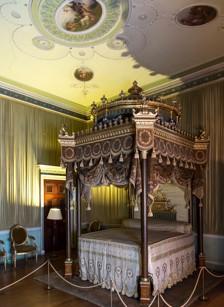



In the late 1700s there were three main furniture designer that were considered to be the most iconic and significant, this included Thomas Chippendale, George Hepplewhite and Thomas Sheraton. Hepplewhite was well known for creating light, elegant and small pieces. The author of the book “The Cabinet Maker and Upholstery Guide’, he designed items with curvilinear shapes, elaborate carvings, straight legs and contrasting veneers and inlays. These were considered ‘city’ furniture pieces, far more sophisticated than items from previous eras with new techniques such as mixing wood types (mahogany, satinwood and maple). One of his more famous pieces is the shield back chair.
Published four volumes of ‘Cabinet-Maker and upholsters Drawing Book’, another key publication during of its time. Sheraton designed ne classical pieces with straight legs and square backs that were smaller in size yet very elegant. There complex designs in the shape of tables with pull out compartments and storage and dressing tables with swinging mirrors (right).

An Adam inspired carved marble fireplace, where the decoration of the pillars echoes the detail on neoclassical chair and table legs.

A Robert Adam designed luxurious chair crafted by Thomas Chippendale.

Mahogany and ebony commode. A blend of wood popularised by George Hepplewhite.

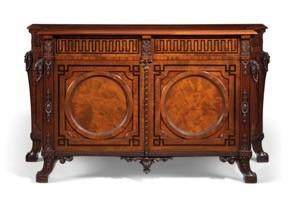
Furniture – Straight leg tables and chairs. Dressing tables, veneered cabinets, small tables, night tables, bookcases, sideboard. Focus on fireplace. Accessories such as urns, jugs, statues, table lectern, grandfather clock, framed mirrors. Made from mahogany and stain wood (newly introduced).
Motifs – Beading, swags, ribbons, feathers, medallions, leaves, floral, vases and urns, classical figures (gods, myths, heroes, literary characters), creatures (lions, sphinxes, bulls, rams).
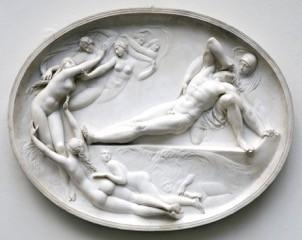
Floors – Carpets to match the patterns and scenes painted on the ceilings.
Lighting – Lanterns, crystal chandeliers, wall scones and candelabras.
Walls – Blank walls in flat colours with decorative carving and molding. White ceilings with
Doors – Mahogany with gilt bronze accessories.
Skilled crafted mahogany grandfather clock(below) with the hands in Romans numerals. The Greek inspired pottery (right and below) with classical figures and intricate detailing.
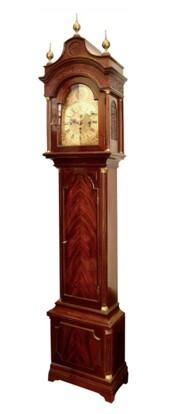
Windows – Sash windows, curtains with pelmets and pull up blinds.
A prevalent mint colour with intricate detailing in the carving and ornamentation.
A pair of classic Wedgewood Blue urns.


Fabrics – Upholstered furniture fabrics matched the colours int her room. Damasks, stamped velvet, stripped patterns. Fabric wallpapers with classical designs.
A table lectern, carved out of walnut wood designed for the purpose for placing a oak sloped at an angle for ease.


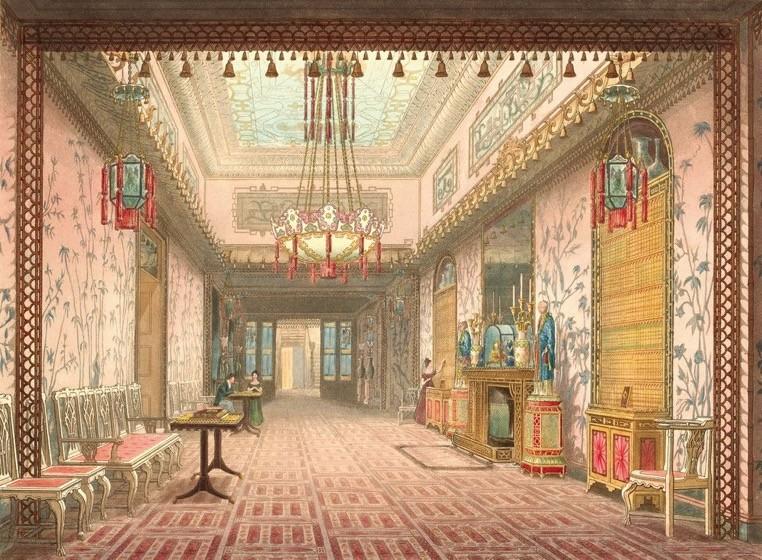
After his father fell ill Prince George became the country’s acting monarch, distinguished as Prince Regent, and this period of time became known as the Regency era. There were noteworthy changes in society and the economic landscape within Britain as well as a wide divide between the high class and the lower classes in society. Following on from the Napoleonic wars (1803 – 1815) Britain suffered economic and financial damage with mass unemployment and an increasingly unsettled society. Working classes were plummeting into poverty due to escalating taxes and there were advancements in agriculture resulting in less labourers required to work on harvests. On the other hand, the upper classes had ever more extravagant and sophisticated lifestyles, with Prince Regent acting as a tastemaker for the refined arts including décor, literature, music and technology. Celebrated for his over the top interests Prince Regent was nicknamed the ‘First Gentleman of Europe’ notorious for his excessive shopping, lavish life and had substantial influence on the wealthier members of society during this era.

• Prince Regent
• John Nash
• Thomas Hope
• George Smith
• Rundell & Bridge
• Sir Charles Monck
Middleton
• Charles Augustin Busby
• Henry Holland
• Sir John Soane
• Charles H. Tatham
• Thomas Sheraton
• Thomas Chippendale
• George Hepplewhite
• Jane Austen


Formerly designed by Henry Holland as a modest country home for Prince Regent, who was in debt after his excessive and lavish spending sprees. Holland captured inspiration from Rome and China with exported furniture and decorative pieces. Nevertheless, it was after Prince Regents debts were cleared that the Royal Pavilion took on another transformation as a grand, chic, unrestrained structure figurative of the luxurious flair within the Regency period.
In 1815 John Nash (who also designed Buckingham Palace above) was selected to convert the reserved villa into a grandeur palace, with cast iron frame and glass dome roofs. Reminiscent of Indian style architecture (minaret, dome and pinnacle) with a Chinoiserie interior décor (left), an opulent and exceptional design suited to the fulsome existence of Prince Regent. An exquisite and confident display of wealth, style and fashion the construction altered the Brighton seafront, creating a retreat for the rich and affluent to visit, play and exhibit their prosperity and social status.
Continuation of classic Georgian townhouses are a central architectural degree of this style period with simple white or cream stucco walls, slender lines, bow windows and balconies as well as black front doors and ornamental iron railings. This graceful and elegant architecture is best seen in London districts such as the residential terraces and crescents of Regents Park (far right).


Characterised by the fusion of Classical, Oriental, Roman, Greek and Naturalistic styles, Regency is most certainly magnificent, plentiful and exciting. An outlandish quality that blends inspiration and exotic cultures, with many designers recreating or adapting foreign design elements to their work.
Greek – The utilisation of an ancient world including gods, wild animals or sphinx motifs as well as classic form with Greek inspired columns and statues. Visually intriguing and a decadent form of storytelling used in the detailing and ornamentation of interiors and architecture.
Egypt – After Napoleon’s Egyptian campaign, stimuli arose in design and architecture including motif symbols (lyres and sphinxes), classic friezes on wallpapers or along the exteriors of buildings.
China – A naturalistic and romantic version of chinoiserie with rich colours, floral imagery and natural materials, for example bamboo wood or bamboo imitated lacquer finishes. A strong sense of detailed ornamentation that feels glamorous, exotic and exclusive.
Naturalistic – The upper class were resorted to drawing influence from their countryside landscapes due to a trade block with France preventing foreign influences. Looking closer to home for inspiration, these naturalistic and organic features became established as Picturesque.
The Pall Mall residence given to Prince Regent in 1783, the interiors are a prime example of opulent Regency style.


 Carlton House
Carlton House
Born in Holland, Hope is a vital designer within the Regency period and one of the first that coined the term ‘interior decoration’. Hope was recognised for his 1807 book ‘Household Furniture and Interior Decoration’, in which he pronounced the furniture and décor of that era and claimed that interior style should be harmonious and balanced. A must have manual for the upper classes and fashion-conscious participants of modern culture and society at the time.


Furniture inspired by French Empire style, featuring elements taken from ancient Greek, Rome and Egypt. The English regency chairs (top right) showcase wooden frames painted in black with gilded details. The motif of a lion along the carved legs are imaginative and distinctive. Bookcase made from mahogany wood with decorative veneer and ornamental details in brass (right).



Authored ‘A Collection of Designs for Household Furniture and Decoration’ in 1808, in which he illustrated the themes and preferences for Regency style, not dissimilar to Hope’s book but with the addition of Chinoiserie and Gothic designs. One of the Regency’s most celebrated designers, Smith was also legendary for his furniture and décor accessories such as the beautifully crafted circular table (below right) and boot scrapper (below).
Furniture – Comfortable, lavishly upholstered sofas, chairs and chaise lounge. Regency Chairs with elegant mahogany or rosewood structure, circular tables in the center of the room, ‘occasional’ side tables introduced.

Floors – Patterned carpets that stretch the length and width of a room.
Lighting – Introducing of oil lamps.
Walls – Plain painted walls with classical motif cornices and ceiling roses. Striped walls. Painted effects of marble, wood grain, bamboo wood. Marble or wood fireplaces with classic and exotic motifs and gilded mirror frame / landscape paintings above. Convex and concave mirrors introduced.
Doors – Simple, paneled doors. Tall double doors in interior. Rosewood and mahogany doors and skirting detailing.
Chaise lounge in one of the preferred fabrics of the time, silk. Sumptuous, lavish and luxurious.

Windows – Introduction of bow windows. Elaborate, theatrical window treatments, heavy drapery with swags, tails, fringes, tassels, braids and ropes. Naturalistic brass hold backs (acanthus, laurel, bay leaf). Subtle muslin against the glass.
Fabrics – Damask, striped silks, glazed fabric taffetas.
Motifs include lions, Egyptian figures and winged classical figures like the one seen on this lamp (right) and the writing table (above).



Bronze, ormolu and black slate paper weights.






An era marked by the reign of Queen Victoria (1837 – 1901) in which there was inordinate economic and social transformation in Britain. The Industrial Revolution meant rapid change in the infrastructure of the UK, with growth in the railway service, expanding towns and an upsurge in consumerism. The British empire was reputable and formidable with developing countries around the world, generating more status, wealth and prosperity. Outer influences escalated with connections to other cultures and countries impacting the social stimuli within the UK. International commerce and trade were at an all-time high, and inspirations were sourced from all over the world including Japan, which for the first time began foreign trade. Britain was considered the financial capital of the world, and this impacted the customs and manners in which the British people lived. Wealthier families decorated their homes in order to present their affluence through architecture, furnishings and home accessories. Mass-produced goods and products multiplied, with a need for improved manufacturing and a growing market place. British technology was progressing and there was an introduction of new materials (glass, steel, iron) during this era.
An English architect, designer and artist who along with Sir Charles Barry redesigned Westminster Palace after a fire damaged much of the structure. There were excessive structural modifications made to the building including two taller towers with the north one including a clock, today known as Big Ben. Pugin was asked to plan a detailed and wideranging interior that symbolises the balance and mixture of the Victorian era. Pugin encompassed vital characteristics of that time such as wood carved furniture, rich and heavy upholstery, stained glass and modern metal work.
• Sir Charles Barry
• Augustus Pugin
• Joseph Paxton
• Henry Cole
• Prince Albert
• Captain Francis Fowke
• Major Henry Y. D. Scott
• Thomas Cubitt
• Captain Davenport
• Archibald Simpson
• Alexander Marshell
Mackenzie
• Alexander Thomson
• Gilbert Scott

• George Butterfield
• Philip Webb
• CFA Voysey
• Norman Shaw
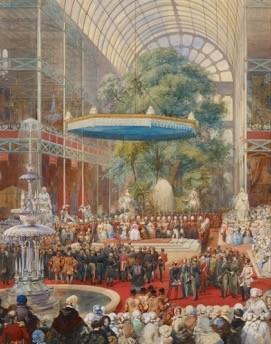

An assembly of art and design, Henry Cole, an inventor and civil servant, along with Queen Victoria’s husband Prince Albert, were encouraged by exhibitions such as the French ‘Industrial Exposition’ in 1844 and strived to create a British equivalent. Cole had an enthusiasm for the arts as editor of ‘Journal of Design’ and saw this presentation as an opportunity to display British manufacturing, products, machinery and our agricultural means to the rest of the world.
Joseph Paxton designed the space, known as Crystal Palace, a cast iron and glass conservatory structure based on his design for Chatsworth House for the Duke of Devonshire. An example of Victorian architecture, Crystal Palace was ground-breaking, gallivant and daring. It was also structurally prevailing in its use of inexpensive materials and simplicity to assemble and dismantle, eventually moving location from Hyde Park to Sydenham.
The showing was incredibly successful with Queen Victoria opening the exhibition and an estimated 6 million people that subsequently visited Crystal Palace during this time. On display there was an array of merchandise and artefacts including ironwork, metal work, pottery, porcelain, taxidermy, furniture and fabrics. Items were not just made in Britain, but all over the world including countries such as Turkey, India and Russia. The financial success of the exhibition meant that Henry Cole was able to craft further museums with the profits in South Kensington, including The Victoria and Albert Museum, The Museum of Natural History and the Science Museum.
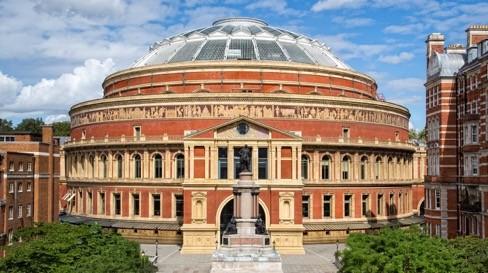
Designed by civil engineers, Captain Francis Fowke and Major Henry Y. D. Scott and opened by Queen Victoria in 1871. The grand architectural structure is reminiscent of ancient amphitheatres and was motivated by an intermingling and fusion of Italianate style (Fareham red bricks, terra cotta block decoration, mosaic frieze and the wrought iron circular dome).

Design by Thomas Cubitt and Prince Albert, Osborne House was a quiet, remote hideaway home for Queen Victoria, and was the eventual place of her death in 1901. Osborne house showcased Italianate style, shaped and motivated by Italian villas with architectural details such as column and tall posts, belvedere towers and front porches.
 The Royal Albert Hall
The Royal Albert Hall

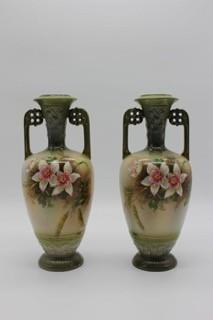
The Victorian style was characterised by a blend of previous design movements including Gothic, Rococo, Louis XIV and Elizabethan. A consequence to the symmetry and straight designs within Palladianism (a style based on the Italian architect Andrea Palladio) Victorian style was an assortment of innovative technologies teamed with nostalgic references to the past. Fortune and riches were illustrated through Victorian architecture, as upperclass families lived in Italian inspired detached villa style homes, whereas the middle class lived in terraced houses built in long rows. Architecture appeared in everything from red brick (Gothic influence) to white stucco (Italian influence) and were designed to accommodate family lifestyles. Interiors highlighted functional rooms with intention, such as a study, a parlour room (seen below right), or a room for the children to play in. Residential homes were cosier and less formal, yet still indicated wealth and status in the décor and possessions that were revealed such as vases and embellished picture frames (seen right). Social changes in Britain allowed for increasing cultural influences, including Indian, Japanese, and Italian. Demonstrated through architecture, design and interiors, these inspirations meant Victorian style was varied, diverse and eclectic.


Furniture – Heavy embellishments and carving decoration (leaves, vines, fruits, ribbons and bows). Dark finishes, gliding. Wood – oak, walnut, mahogany, rosewood. Furniture arranged in groups creating separate areas. Introduction of spring plump chairs (Chesterfield, chaise lounge, conversation seat, ottoman). Small writing desks appeared. Papier Mache furniture in the framework of table, chairs and trays). Chest of drawers, dressing tables and wash-stands with mahogany wood.
Floors – Pattered floor tiles in entryways, halls and kitchens. Large pattered carpets and rugs (Axminister, Kidderminster, Brussels, Wilton) and painted wood flooring. Floor cloths (a canvas painted with oils).
Lighting – Great advancement with gas lighting. Electricity appeared at the end of the Victorian era. Brass, tin, iron or pewter materials.
Walls – Bright and cheerful mass-produced wallpaper replacing painted walls. Patterns including stripes, flowers, dots and spots. Ornate fireplaces, in many styles and made of wood, marble and cast iron. Dado reappeared. Moldings made from paper mache.
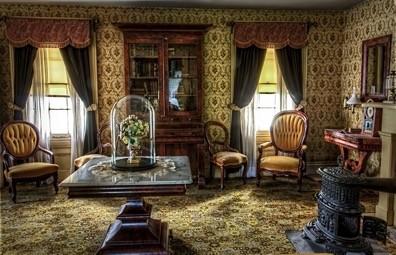
Doors – Dark panels, glazed upper panels. Exterior doors embellished with panel and carving, representative of wealth. Gothic style arches. Brass or porcelain handle details.
Windows – Bay and sash were most popular as well as casement, gothic and French influences. Stained glass. Pelmets down the side of windows (lambrequin), curtain edges with fringes, tie backs cords, tassels, brass leaves etc.
Fabrics – Heavy upholstery and drapes with velvets, damasks, serge, chenille, linens, chintz and cretonne.

The ‘golden age’ of taxidermy in which a décor accessory would be mounted animals displayed within interiors, sometimes in a glass dome like the below example.
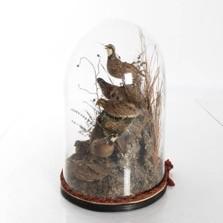
The Davenport desk was first commissioned by Captain Davenport, a small desk with a desktop that elevates and uncovers a storage space, suitable for papers and writing materials. There are hidden compartments, pen slides and clever storage built in with pull out drawers along the edge of the desk, most commonly made in carved solid wood such as this dark walnut one. Alternative home accessories were invented at this time such as the stationery ink well below. During the Victorian style era there was a boosted postal service in Britain, with friends and family writing to one another. This adjustment in society and civilization is suggested in the design of this desk, a charming, exquisite and superb piece for the home.


During the Victorian era there was the invention of the coiled spring, demonstrated within the chairs and seating of this time period. Deep seats with short chair legs including the spoon back chair with a circular open back rest and the balloon back chair (bottom right).


The revival of Gothic style was seen in the remerge of stained glass, and traditional methods were used to reinterpret and craft these pieces centring on the ‘stories’ they depict. A nostalgic ingredient to Victorian style established in these examples King René's Honeymoon made by Ford Madox Brown and Vision of Beatrice by Nathaniel Westlake (right).







The Arts & Crafts movement primarily derived from a reaction against the mass production of products that had begun during the Industrial Revolution. In Britain, working class labourers had to endure long hours for minimal pay in huge factories, which in turn had an adverse impact on their worth and value, as well as a damaging impact on the environment. The Arts & Crafts era sought to recall the skills and ingenuity of traditional, hand-crafted goods and products that were artistic and of a high quality. In 1851, London hosted the first world fair ‘The Great Exhibition’ which suffered criticism due to the presence of manufactured, mass-produced pieces. Arts & Crafts was inspired by the socialist principles and ideas of individuals like John Ruskin and Karl Marx. They believed that the mass-produced, machine-made products were of a poor quality and most importantly they had dehumanising consequences on our population and labourers. The factory methods of ‘division of labour’ effectively eradicated the relationship between an artist and his work, disconnecting the creative process as a whole. William Morris was one of the central figures during this design movement. He opened a design firm called Morris and Co. in 1861 and recruited artists that fixated on nostalgic methods of craft, designing high-quality pieces (furniture, ceramics and textiles). Disenchanted with the social and environmental outcomes of the factory-based systems, Morris encouraged a homecoming to the wellcrafted and creatively independent design world. He wanted the decorative arts to help improve the lives of ordinary people.
• William Morris

• Philip Webb
• Richard Norman Shaw
• CFA Voysey
• Ernest Gimson
• Ford Maddox Brown
• Edward Burne-Jones
• William de Morgan
• Ernest Barnsley
• William Arthur Smith Benson
• Arthur Stansfield Dixon
• Richard Lethaby
• John Ruskin
• Karl Marx
• Frank Lloyd Wright
• H.H. Richardson
• Godfrey Blount
• William Howson Taylor
• Charles Rennie Mackintosh
• Charles Robert Ashbee
Significant in conveying the Arts & Crafts movement within architecture in America. His design known as ‘Prairie Style’ involved low pitched roofs with tall chimneys and an open plan interior space were crucial foundations to his style. Wood or stone buildings, with triangular brackets, squared sections and outdoor porches were all features to the Arts & Crafts style.
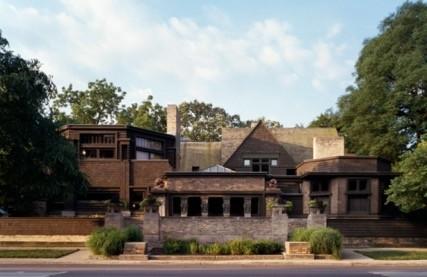
Webb worked with architect Richard Norman Shaw, and he contributed considerably to Cragside in Northumberland. This building demonstrates precision and clarity that matches the Arts & Crafts spirit of ingenuity and love of design. The asymmetry and assortment of materials are all excellent examples of Arts & Crafts architecture, with square columns and exterior chimneys built with traditional methods and an authentic principle of design.

Designed by Philip Webb for William Morris, this building is a notable paradigm of Arts & Crafts architecture. There are found materials, basic form and valued craftsmanship. The red bricks and tiles, steep roof and pointed window arches are origins of this design movement, and in particular Webb wanted to reject the classical styles of architecture, instead producing this exceptional, exclusively constructed structure. This is a lack of recurrence and uniform within this design, and the interior is equally distinctive as Webb designed much of the bespoke furniture.
 Frank Lloyd Wright
A Frank Lloyd Wright house
Cragside
Frank Lloyd Wright
A Frank Lloyd Wright house
Cragside

Burne-Jones created art, not only in paint, but also in tapestry, stained glass and furniture and his pieces were commissioned by Morris and Co. Originally motivated by the church and medieval figures, Burne-Jones mistrusted materialism that he considered was lowering the British culture, and instead focused on the grace, beauty and quality of form within his art. This image (right) shows one of his pieces Love Among Ruins hanging on an oak panelled wall, with ceramic plates lined above. An archetypal interior within Arts & Crafts, as there is an attention to detail, vision and excellence that speaks for itself.


During this era there had been advancements in the processes of rug making with the introduction of mechanization in the weaving process, however William Morris thought this detrimental to the creative process. Morris assembled looms in which the traditional methods of hand weaving rugs could be implemented, and explored the use of vegetable dyes instead of newly established synthetic ones. His rug, carpet and textile designs became infamous with the Arts & Crafts era and the botanic and geometric motifs with earthy colour tones are still to this day recreated and utilised within interiors throughout the world. This Hammersmith rug (seen right in the Oak Room at Wightwick Manor) had a border of repetitive florals, with an indigo and red palette that is authentic and striking in its design. William Morris Sussex Chair (bottom right) designed by William Morris for Morris and Co. this chair has trademark features of the Arts & Crafts design movement with a beech frame, ebonized finish and rush seats. A handmade appearance that symbolises the status of skilled labourers that have designed and built their furniture with imagination and ardour.

Scottish architect and designer, Mackintosh was known for his remarkably imaginative and original interiors. A church, multiple tea rooms, residential interiors and the furnishings are amongst the variety of work he designed. Mackintosh’s work is more of a blend between Arts & Crafts and Art Nouveau which would follow. His designs were vastly modern for the time and he utilised art, creativity and naturalistic elements within his work. Inspired by plant forms, florals and stems his wife Margaret MacDonald Mackintosh helped design ornamental features stirred by these natural forms. Mackintosh was known for the balance and harmony between light and dark, masculine and feminine as well as sensory and innocent.
Hill House (right) is a crucial illustration of his innovative ingenuity and creativity with decorative murals and stained glass on windows and doors. Mackintosh paid tribute to traditional Scottish values and the authentic, quality craftsmanship of the Arts and Crafts era. There was a sense of adventure within his furniture projects and décor accessories, such as hanging lights and high back chairs. Geometric shapes emerge throughout the interiors in various ways such as the carpet which uses a contrast of colour and small squares to play with proportion and light.


 Charles Rennie Mackintosh
Charles Rennie Mackintosh

A concentration on the ethos and excellence of design practise was vital within the Arts & Crafts movement, as the significance of originality and the gratification that a craftsperson obtained from work was imperative. Authentic and meaningful design as one individual is responsible for the construction and handiwork of an item. The Arts & Crafts style was modest and minimal with less excess and an awareness on the functionality of design. Simpler patterns and attention on ‘nature’ motifs (flowers, vines, leaves, animals, insects and birds). Straight lines, rounded forms and earthy colour tones formed a composed and unassuming purpose to interiors. The decorative arts were no longer principally for the upper-class, Morris wanted to ensure his objects were accessible to everyone for everyday life (however this was not practical as pieces were often too expensive for the working class to afford). Workshops in rural areas were given free rein to produce what they wish, hand-crafted furniture indicative of the traditions of the British countryside. Interiors were inspired by nature as well as medieval art, unpretentious figures with minimal ornament and a spotlight on the splendour of natural materials.
Craved Oak Bookcase (top right) designed by American architect Henry Hobson Richardson in 1880. His work was stirred by William Morris and the Arts & Crafts design movement. This bookcase exhibits the quality of handcrafted furniture with carved wood and engravings lending themselves to exceptional worth. The materials are also features within the time period, oak wood and ornate bronze details.

Copper Wall Light (right) designed by Arthur Stansfield Dixon, who founded the Birmingham Guild of Handcraft, this light is beautifully handcrafted with a hammered copped shade. Dixon's guild was the first to design handmade metal work in Birmingham, and their style and creativity was unique, and invocative of its time. There is a simplicity and modernity to this design that fits with the honest and purposeful aesthetic of the Arts & Crafts movement.

Furniture – Hand-crafted wood, mostly bleach-oak, with ladderback chairs and rush or leather seats. Strong lines and structure, purposeful and practical design.
Floors – Wooden parquet (polished oak or pine), will wool rugs.
Lighting – Hanging electric pendants are available. Oil and electric lamps with glass shades. Table lamps that are copper or brass. Plain wall scones.
Walls – Wood panelled. Plainly painted in whites, light blues and greens. Wallpaper with large scale pattern repeats. Introduction of plate racks and picture rails.
Doors – Stained and polished oak, panelled with plank ledge or brace doors.
Windows – Casement, stained glass used, plain curtains hung on plain wooden or brass poles.
Fabrics – Linen, cotton, cretonnes with patterns.
A Mackintosh mirror stand (top right), made from oak wood and painted white with classic Mackintosh features such as the floral detailing, silver brass handles on tiny doors and pink stained glass.

The infamous Mackintosh high ladder back chair (above right) with straight logical lines, geometric shapes and high quality craftsmanship.
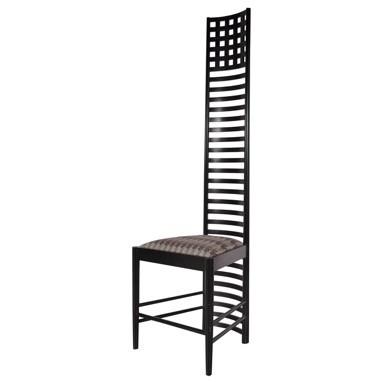
The gesso panel (bottom right) of sleeping beauty from Hill House designed by Margaret MacDonald Mackintosh. A focus on floral and plant life imagery, also featured on the Mackintosh silver wall light (title page).
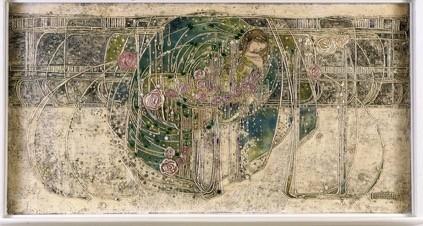

Websites
peacocksfinest.com vam.ac.uk mayfairgallery.com pinterest.co.uk christies.com thecultureconcept.com 1stdibs.com britannica.com archdaily.com, visitisleofwight.co.uk royalalberthall.com, pedlars.co.uk, antiques.co.uk, sellingantiques.co.uk nts.org.uk visitlondon themagazineantiques.com laurelhurstcraftsman.com skeltonculver.com fourcenturies.org brightonmuseums.org.uk commons.wikimedia.org nicholaswells.com marathigazal.com
House and Garden
The Telegraph Architectural Digest Elle Decoration Living Etc. Wallpaper Country Living Elle Decoration Country Books
Blomquist, H. (2016) InTheMoodForColour Fu, A. (2014) AndreFu Maynes, T. (2015) TheMaker
V&A William Morris Gallery Hill House